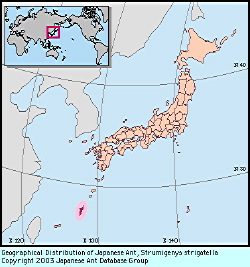
|
species
|
Strumigenys strigatella
|
 |
Japanese Name
|
Kakugao-uroko-ari
|
Original Reference
|
|
Bolton, B. (2000) The ant tribe Dacetini part 2. Memoirs of the American
Entomological Institute, 65: 492-1028.
|
Description
|
|
Total length of workers around 2 mm. Body color brown. Anterior portion of head at the level of antennal insertions not distinctly constricted, so that the head is somewhat trapezoidal in full-face view. Distance between dorsal tooth of apical fork and subapical tooth on mandibles rather short. Dorsal outline of mesosoma from posterior half of mesonotum to base of propodeal spine almost straight. Infradental lamellae of propodeum with widely concave outer margins.
|
Remarks
|
|
This species is similar to S. lewisi in general appearance, but separable in having fine punctures on the mesopleuron and lateral surfaces of the propodeum, and by the shape of its head. Corresponding to Strumigenys sp. B of Onoyama (1976) and S. sp. 3 (Myrmecological Society of Japan Editorial Committee, 1988). A rare species, found on several occasions in big chinquapin tree trunks at a wood-chipping factory, and from natural forests.
|
|

Distribution
|
|
Northern part of Okinawa I. (Yona [Fumiyasu Sato leg.], River Fukugawa [Keiichi Onoyama leg.], Mt. Terukubi [Kazuo Ogata leg.]).
|
|
References
|
|
- Onoyama, K. (1976). A preliminary study of the ant fauna of Okinawa-Ken, with taxonomic notes. (Japan: Hymenoptera: Formicidae). . Ecol. Stud. Nat. Cons. Ryukyu Isl., 2, 121-141.
- Myrmecological Society of Japan, Editorial Committee (ed.) (Ed.). (1988). A list of the ants of Japan with common Japanese names. The Myrmecological Society of Japan, Tokyo.
|
Editor
|
|
Original text by Kazuo Ogata, Keiichi Onoyama and Mamoru Terayama. English translation by Kazuo Ogata, edited by Robert W. Taylor.
|
|